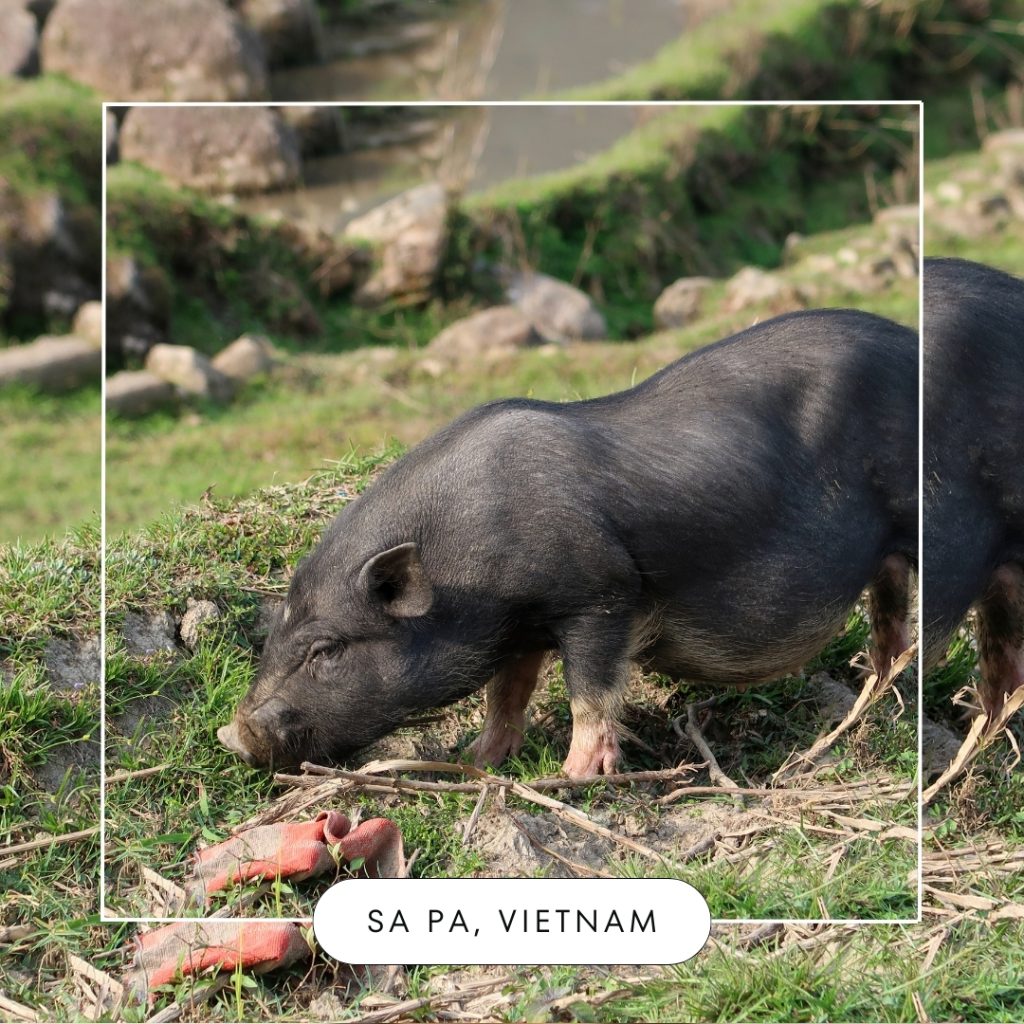Sapa is famously known for its trekking and the vibrant ethnic minority communities that live in the valleys and mountains around the town. So if you’re interested in multi-day hikes and learning more about Vietnam’s ethnic minority culture, Sapa would be a great choice! The journey from Hanoi to Sapa or back is not so long, but it is challenging as it goes through the mountainous area. The two areas are approximately 315 km (200 miles) apart, with Sapa sitting north of Hanoi. There are five options between these two areas: bus, limousine, train, taxi, and most exciting way: scooter.

How to travel to Sa Pa from Hanoi?
TAKING THE BUS
You can easily book a bus from the Hanoi Old Quarter to Sa Pa almost every hour during the day, and the journey takes around 5 to 5 and a half hours. Buses are available every day, but usually busier on the weekends. The cost is about 250.000 VND ($13) per person for a one-way fare. The reverse route and bus are precisely the same.

Contact us to arrange the simplest way to travel to Sapa From Hanoi.
GETTING THE TRAIN FROM Hanoi To Sapa
Trains run from Hanoi to Sapa throughout the day – it usually takes eight and a half hours to get there, depending on how often the train stops along the way. But it would be best if you took a taxi from the train station in Lao Cai city to the hotel you are staying in (about 35 km to Sapa).
A single fare costs about 320.000 VND ($15) per person, and again, the train runs every day.

Limousine From Hanoi To Sapa
Running seven days a week, a limousine is the most flexible travel method. The limousine is a ten-seater minibus that runs to no fixed schedule and is particularly prevalent when there is a limited bus or train service (in the evenings) or none, at night, or mainly on the Vietnamese new year when there is no bus running.

The main difference is that, within Hanoi and Sapa, they will pick up and drop off at any point along the way, and out of the city, at any junction or bus stop (even those not served by the bus route).

DRIVING
Renting a scooter and driving to Sapa is the most exciting way. Hanoi- Lao Cai highway (Highway CT05). It is the fastest way to get between the two areas, and without traffic, driving takes around five and a half hours. However, during busier hours, it could easily take twice this time. Google Maps will help you find the road quickly.

Sa Pa is a beautiful and colorful town in Vietnam, renowned for its spectacular vistas over the surrounding mountains and valleys. This breathtaking destination, located in the Hoang Lien Son Mountains, is home to different ethnic tribal groups and is known for its trekking trails. The town’s charm is enhanced by its cool climate and mist-covered landscapes, making Sa Pa a must-visit destination for nature and culture enthusiasts.

Getting from Hanoi to Sa Pa is fairly straightforward. There are three main options: by train, by bus, or by private car. The train journey is the most popular option and takes about 8 hours. There are both day and overnight trains available. The bus journey is faster, taking about 5-6 hours, but the roads can be winding and bumpy. If you prefer a more comfortable and flexible journey, hiring a private car could be the best option, but it is also the most expensive.

Some of the top sights to see in Sa Pa include:
- Sa Pa Lake: Located in the heart of the town, this gorgeous lake is the perfect spot for a leisurely stroll.
- Fansipan Mountain: Known as the Roof of Indochina, it’s the highest peak in the region. Adventurous travelers can take a cable car or hike up to the summit for stunning views.
- Muong Hoa Valley: This is a beautiful area known for its terraced rice fields. The valley is also home to many of Sa Pa’s ethnic minority villages, providing a glimpse into local life.
- Silver Waterfall: Located about 15km from Sa Pa town, this waterfall is impressive, especially during the rainy season. Nearby, there’s also the Love Waterfall, another natural beauty.
- Ham Rong Mountain: Easily accessible from Sa Pa town, the mountain offers lovely gardens and a panoramic view of the town below.
- Local markets: Sa Pa is known for its vibrant markets, where local tribes sell their handmade crafts and produce. The Bac Ha market, held every Sunday, is particularly popular.

Hanoi: Transfer to or from Sapa in a Sleeper Bus
Travel comfortably between Hanoi and Sapa with the pre-booked sleeper bus service. Start from either pickup point and listen to information about the route. Enjoy the views or rest up for your next adventure. Choose the departure time that fits your schedule.

Where to stay in Sa Pa
There are numerous accommodation options in Sa Pa, catering to different budgets and preferences. Some of the top choices include:
- Victoria Sapa Resort & Spa: This is a luxury resort, offering stunning views of the surrounding landscapes. It’s equipped with modern amenities and a spa for guests to relax and rejuvenate.
- Sapa Elegance Hotel: Located in the town center, this hotel offers comfortable rooms and easy access to local attractions.
- Go Sapa Hostel: A great option for budget travelers, this hostel is known for its friendly staff and clean rooms.
- Topas Ecolodge: Situated on a hilltop outside Sa Pa town, this ecolodge offers a unique stay experience amidst nature. The bungalows are comfortable, offering panoramic views of the mountains and valleys.
- Homestays in local villages: For a more immersive experience, consider staying in a homestay in one of the local villages. It’s a great way to learn more about the local culture and lifestyle.
From Sapa: 1-Day Guided Trek to Lao Chai & Ta Van with Lunch
Explore the culture and scenic landscapes of Sapa on this guided 7.5-mile trek to Ta Van. Walk through rice terraces, visit the Black Hmong village of Lao Chai and enjoy a traditional homemade lunch. Join the experience with the local.

- Enjoy the unique and mouth-watering local flavors of the Sapa region during a traditional meal in the quaint village of Lao Chai.
- Immerse yourself in the tranquility and beauty of nature, marvel at the magnificent and meticulously carved terraced fields crafted by the industrious Hmong people.
- Delve into the fascinating culture, age-old traditions, and captivating history of the Hmong and Zay ethnic groups. Discover their customs, folklore, and way of life, and gain a deeper understanding of their heritage.
- Embark on an unforgettable trek through the stunning landscape, wandering past gently flowing streams and towering, awe-inspiring mountains. Experience the sheer majesty of nature untouched and unspoiled.
- Participate in an authentic cultural experience by learning the traditional method of making incense. Using local herbs collected from the lush surroundings of Ta Van village, learn this ancient craft under the guidance of the local villagers.

Custom Day Trek Adventure
Embark on a unique trekking experience with a local Hmong guide. The Hmong people are an ethnic group native to the mountainous regions of Vietnam, and who better to guide you through the beautiful landscapes of Sapa than one of its local inhabitants?

Start the day early and meet your Hmong guide, who will lead you through the verdant fields and rugged trails. Along the way, learn about the Hmong culture, traditions, and their close relationship with the land.
Your trail takes you to a Hmong village, where you will get a glimpse of their daily lives. Learn about their traditional farming methods, observe their skilled craftsmanship, and maybe even get a chance to try your hand at some of their cultural practices.

After a hearty lunch prepared by a local Hmong family, continue your trek to higher altitudes. Enjoy the sweeping views of the picturesque landscapes, terraced fields, and majestic mountains.
The trek ends with a sense of accomplishment and a greater understanding of the Hmong people and their way of life. This is not just a trek, but a cultural immersion that allows you to connect with the local people and their natural environment in a meaningful way.

What is the best time to visit Sa Pa?
The best time to visit Sa Pa is from March to May and from September to November. During these months, the weather is fairly settled with dry sunny days and cool nights.
How do I get from Hanoi to Sa Pa?
There are three main options to get from Hanoi to Sa Pa: by train, by bus, or by private car. The train journey is the most popular and takes about 8 hours. The bus journey is faster, taking about 5-6 hours, but the roads can be winding and bumpy. Hiring a private car is the most comfortable and flexible option, but it is also the most expensive.
What are some must-see attractions in Sa Pa?
Some of the top sights to see in Sa Pa include Sa Pa Lake, Fansipan Mountain, Muong Hoa Valley, Silver Waterfall, Ham Rong Mountain, and the local markets. The Bac Ha market, held every Sunday, is particularly popular.

